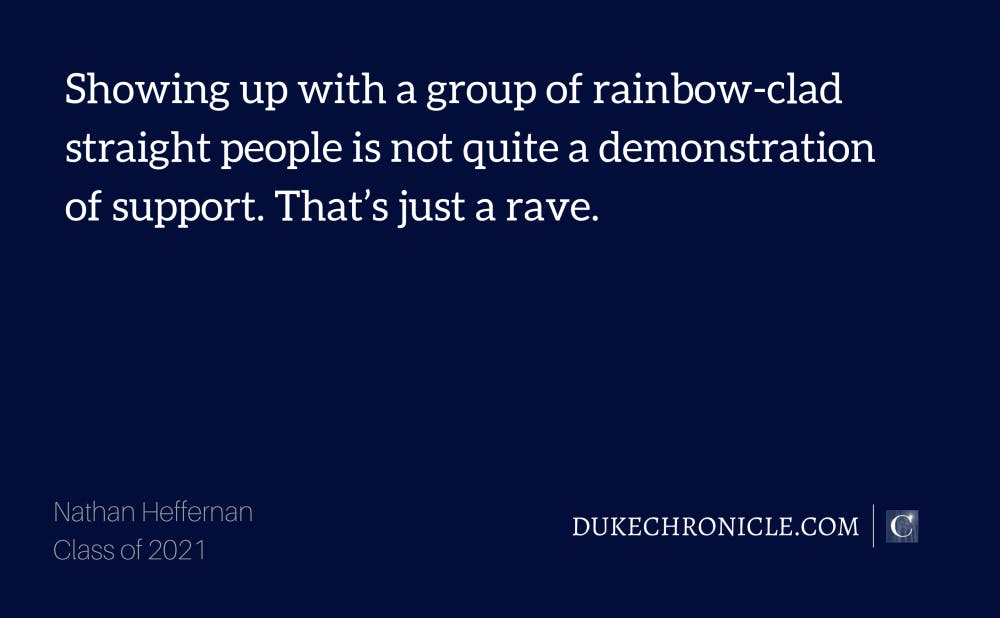As if "Friends" remaining on Netflix did not satisfy the heterosexual public enough, “straight pride” is the newest act of defiance against the rainbow wave.
Earlier this month, headlines erupted as three Boston men planned a straight pride parade in their hometown. They sought to satirize the “identity politics” of the modern LGBTQ pride celebrations taking place across the nation. These men felt that their city celebrating gay pride was a form of favoritism. And although their particular action was dramatic, their sentiment that the pride festivities are too big and too obnoxious was echoed by many online.
Several people have “innocently” asked me why pride is even celebrated at all. “If you are gay, that’s cool, but why do you need a float?” The general American public may be in favor of the most basic human rights for queer people, but actual acceptance of queer humanity eludes us. This tension in progression stems from the fact that the narratives of gay people are not being told by the gay people themselves.
On June 28, 1969, police raided the Stonewall Inn, a popular gay club in New York City. Stonewall was unique in its function as a place of refuge for gay individuals, particularly drag queens and gays of color, who were marginalized even within the larger gay community. The police began arresting individuals for dancing with members of the same sex, forcefully checking the genitalia of individuals, and issued tickets to butch lesbians for wearing gender inappropriate clothing. Such a raid was typical, but on this night the patrons fought back and resisted arrest. The Stonewall Riots were born, and inspired demonstrations across the country, which evolved into annual pride celebrations.
Gatherings of the LGBTQ community are not born out of a celebration of identity—they are born out of necessity. Anti-gay laws and social settings forced queer people to create underground communities that were breeding grounds for art and resistance. When the AIDS crisis struck the heart of gay communities, and the U.S. government ignored their suffering, gay people found solace in each other. When queer people are abandoned by their families or ridiculed by their peers, they find a chosen family among each other. It is only after acceptance from others that we begin to take pride in our identities, and ourselves. This long, difficult development in every queer person’s life is what we celebrate this June.
Ideally, the intricacies of queer history would be taught by queer authors and artists. However, the general public is not often exposed to the wider realms of queer media and entertainment. Instead, corporations dominate the publicity of pride through advertisement campaigns and logo changes on social media. Colorful text and superficial slogans like “be your true self” and “live your pride” are the representations of the queer community in this modern pride season. The acceptance of the LGBTQ community by corporate America happened so swiftly in the past few years that these powerful voices overtook those of the queer community itself.
Pride is made by and for the LGBTQ community. The glamorization of allyship and rainbow capitalism have diluted feelings of solidarity that come from purely queer communities. It is important to understand that historically, the strength of the LGBTQ community was created by mutual suffering. The love and acceptance found in a group of other queer people with similar experiences is what births that community.
As a gay man, I have learned not to seek the acceptance of my straight peers. And I certainly do not seek the support of corporations touting the rainbow flag. I attend pride to relish in the love and support of the queer community. I enjoy seeing support from straight people, and I understand how much growth it requires to undo societal conceptions. But I will never rely on validation from the general public.
For those who still don’t understand pride, just don’t go. You won’t exactly be missed. I know it’s hard to avoid the swarm of corporate advertisements, but find comfort in knowing that most gay people are annoyed with them too. The queer community is not looking for your support during pride. The disgust and intolerance of others is nothing new.
For allies, feel free to attend pride with your queer friends and family who invite you. Know that this is a space created for them, and it’s one that they might not get often. If you want to truly show your support, you can donate to LGBTQ causes, vote for LGBTQ issues and educate yourself on queer history. Showing up with a group of rainbow-clad straight people is not quite a demonstration of support. That’s just a rave.
If you do end up attending a pride celebration, you might see an assortment of risqué activity. Maybe some old folks in leather, a scantily clad cosplayer or people twerking on top of a police car. You may not completely understand their actions, but you can respect their happiness. Queer people have been bold, rambunctious and provocative for decades behind closed doors. Now the music, slang and colorful attire is displayed in the open. For many members of the queer community, this is pure liberation.
Among the sea of rainbow costumes and glitter clouds at pride, there is also a nervous teen staring in awe at the spectacle around him. He didn’t tell his parents where he was going and wore a jacket to cover up his rainbow shirt. To just stand there is an accomplishment seven years in the making. The boldness of others makes him feel regular, for a singular moment. And he catches a glimpse of the happiness his future holds.
That’s why I celebrate pride. For the person I was, and the people like me.
Nathan Heffernan is a Trinity junior.
Get The Chronicle straight to your inbox
Sign up for our weekly newsletter. Cancel at any time.

